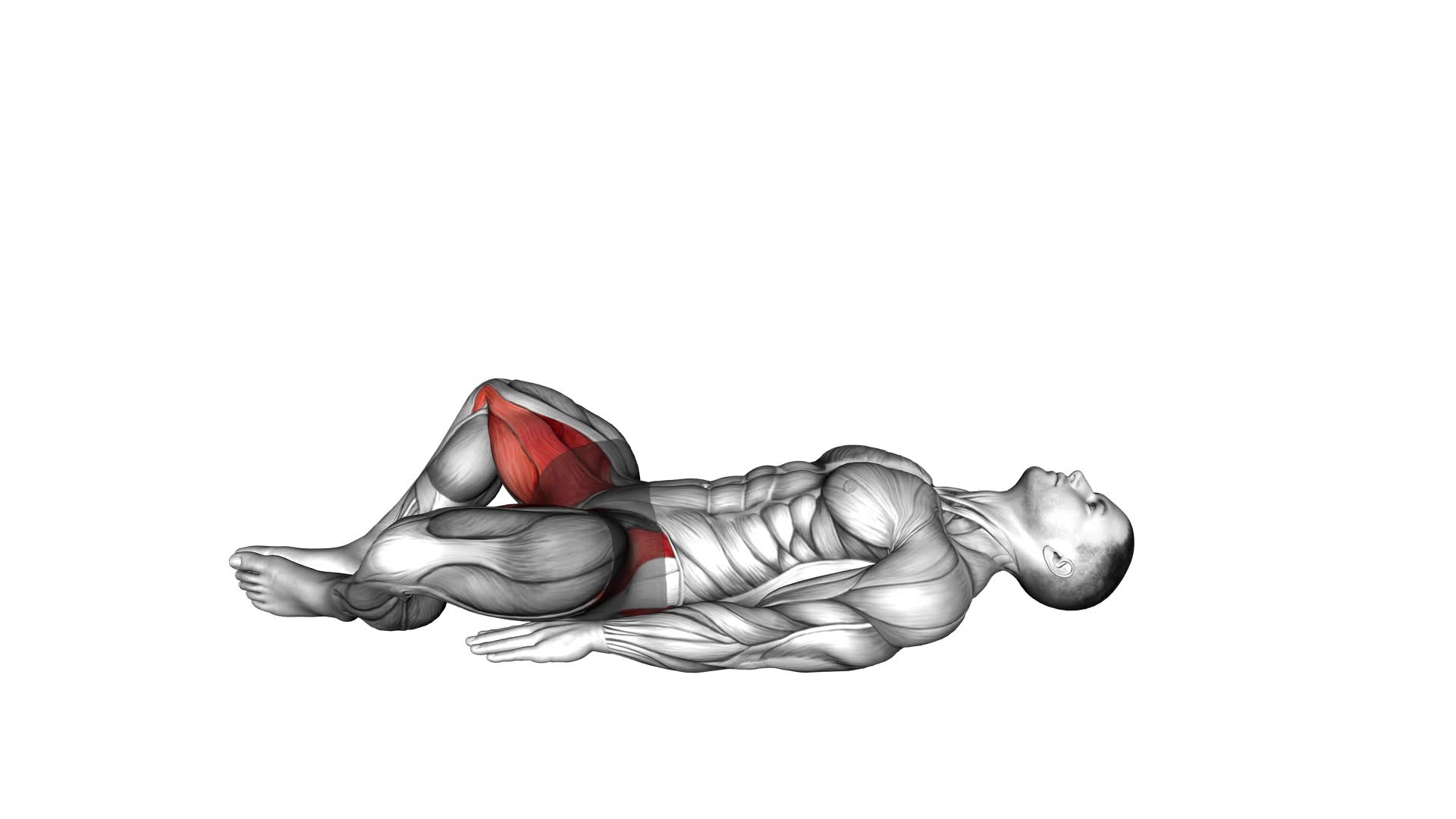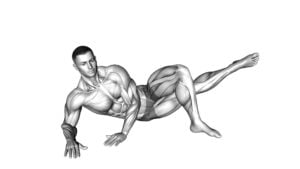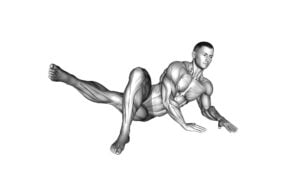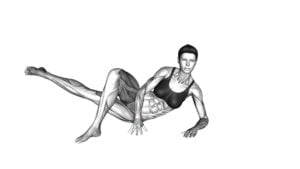Lying Hip Adduction (male) – Video Exercise Guide & Tips

Get ready to strengthen your hip muscles with lying hip adduction! This video exercise guide and tips will show you how to properly perform this male-targeted exercise.
Watch This Exercise Video
By following the proper form and incorporating variations, you can maximize your workout and reap the benefits of increased hip strength.
So, grab your equipment and let's get started on improving your hip adduction with this informative video guide!
Key Takeaways
- Lying hip adduction targets the inner thigh muscles and improves lower body strength.
- It enhances stability, balance, and hip stability.
- The exercise helps prevent injuries related to the hip and groin.
- Proper form and technique are crucial to maximize the benefits and avoid common mistakes.
Benefits of Lying Hip Adduction
What are the benefits of Lying Hip Adduction for you?
Lying hip adduction is an exercise that targets the inner thigh muscles, helping to improve overall lower body strength. By incorporating this exercise into your leg workout routine, you can experience several benefits.
One of the main advantages of lying hip adduction is that it specifically targets the adductor muscles, which are responsible for moving your legs inward. Strengthening these muscles can enhance your stability and balance during various activities, such as running, jumping, or even walking. Additionally, strong adductors can help prevent injuries by providing better support to the hips and knees.
Moreover, including lying hip adduction in your leg workout routine can contribute to a well-rounded lower body workout. It complements other exercises that primarily target the quadriceps, hamstrings, and glutes, ensuring that all major muscle groups in your legs are adequately trained.
To incorporate lying hip adduction into a well-rounded leg workout, start by lying on your side with your lower leg bent and your upper leg extended straight. Place a resistance band just above your knees and squeeze your legs together, engaging your inner thigh muscles. Repeat for a desired number of repetitions and then switch sides.
Equipment Needed for Lying Hip Adduction
To perform lying hip adduction, you'll need a resistance band. The resistance band is a versatile piece of equipment that will effectively target your hip adductor muscles. Here are some other equipment options you may consider:
- An exercise mat: Provides comfort and support during the exercise.
- Ankle weights: Adds extra resistance to intensify the workout.
- Fitness ball: Can be used to elevate the legs, increasing the range of motion and difficulty of the exercise.
- Cable machine: Offers a different variation of the exercise, allowing you to adjust the resistance and target the muscles from different angles.
When it comes to technique, it's important to maintain proper form throughout the exercise. Here are some tips to keep in mind:
- Lie on your side with your legs extended and stacked on top of each other.
- Place the resistance band around your ankles.
- Slowly lift your top leg towards the ceiling, keeping it straight.
- Pause at the top for a second, then lower your leg back down in a controlled manner.
- Repeat for the desired number of repetitions, then switch sides.
Remember to start with a lighter resistance band and gradually increase the intensity as you become more comfortable with the exercise.
Proper Form for Lying Hip Adduction
Maintain proper form for lying hip adduction by keeping your legs extended and stacked on top of each other. This exercise targets the muscles of the inner thighs, specifically the adductor muscles. To ensure proper form and maximize the effectiveness of the exercise, it's important to avoid common mistakes.
One common mistake is allowing your top leg to rotate or lift off the bottom leg. This can reduce the engagement of the adductor muscles and shift the focus to other muscles. Another mistake is lifting your hips off the ground or arching your lower back. This can put unnecessary strain on your lower back and take away from the targeted muscles.
To maintain proper form, start by lying on your side with your legs extended. Keep your bottom leg straight and in line with your body. Stack your top leg directly on top of the bottom leg, making sure to keep both legs parallel. Engage your core and maintain a neutral spine throughout the movement. Slowly lift your top leg towards the ceiling, focusing on using the inner thigh muscles to perform the movement. Lower your leg back down to the starting position with control.
Variations of Lying Hip Adduction
Try incorporating different variations of lying hip adduction into your workout routine to target the adductor muscles in various ways. Here are some variations you can try:
- Resistance Band Hip Adduction: Attach a resistance band around your legs, just above your knees. Perform the lying hip adduction exercise while maintaining tension in the resistance band.
- Weighted Hip Adduction: Hold a dumbbell or a weight plate between your feet while performing the exercise. This will increase the resistance and challenge your adductor muscles even more.
- Single-Leg Hip Adduction: Perform the lying hip adduction exercise with one leg at a time. This variation helps to improve balance and stability while targeting the adductor muscles of each leg individually.
- Swiss Ball Hip Adduction: Place a Swiss ball between your legs and squeeze it as you perform the hip adduction exercise. This adds an extra challenge by engaging your core muscles.
When incorporating these variations into your routine, it's important to be aware of common mistakes in lying hip adduction. Avoid these errors to maximize the effectiveness of the exercise:
- Allowing your legs to come too close together at the top of the movement.
- Using momentum instead of controlled movements.
- Arching your lower back or lifting your hips off the ground.
- Not maintaining proper alignment of your spine and pelvis throughout the exercise.
For progressions in advanced lying hip adduction exercises, consider increasing the resistance, performing the exercise on an unstable surface, or adding dynamic movements to challenge your adductor muscles even further.
Tips for Maximizing Your Lying Hip Adduction Workout
To get the most out of your lying hip adduction workout, focus on maintaining proper form and engaging your adductor muscles throughout the exercise. This will ensure that you're targeting the correct muscles and maximizing the effectiveness of the exercise.
Here are some tips to help you maximize your lying hip adduction workout:
- Maintain proper form: It's important to keep your back flat against the bench and your feet firmly planted on the ground. This will help prevent any unnecessary strain on your lower back and ensure that you're targeting your adductor muscles.
- Engage your adductor muscles: Throughout the exercise, make a conscious effort to squeeze your adductor muscles. This will help to activate and strengthen them.
- Avoid common mistakes: One common mistake is using too much weight. Start with a light weight and gradually increase it as you become more comfortable and stronger. Also, avoid using momentum to complete the movement. Focus on a slow and controlled motion to fully engage your adductor muscles.
- Progressions and regressions: If you find the lying hip adduction too easy or too challenging, there are progressions and regressions you can try. To make it more challenging, you can increase the weight or use a resistance band. To make it easier, you can decrease the weight or perform the exercise with your knees bent instead of straight.
Frequently Asked Questions
How Many Sets and Reps Should I Do for Lying Hip Adduction?
For lying hip adduction, the number of sets and reps can vary depending on your fitness level and goals. It's recommended to start with 2-3 sets of 10-12 reps, using a weight that challenges you but allows you to maintain proper form.
As you progress, you can increase the number of sets or reps, or use variations of the exercise to target different muscles. Avoid common mistakes like using momentum or lifting your hips off the bench.
Can Lying Hip Adduction Help With Improving Sports Performance?
Lying hip adduction can be beneficial for improving sports performance by increasing power and agility. This exercise specifically targets the muscles in your inner thighs, which play a crucial role in stabilizing your hips during athletic movements. By strengthening these muscles, you can enhance your ability to generate force and maintain balance, ultimately leading to improved performance in sports activities.
Incorporating lying hip adduction into your training routine can be a valuable addition to your overall athletic development.
Is Lying Hip Adduction Suitable for Beginners?
Lying hip adduction is a suitable exercise for beginners. It targets the inner thigh muscles and helps improve hip strength and stability. By performing variations of the exercise, such as using resistance bands or ankle weights, you can gradually increase the intensity as you progress.
However, it's important to be aware of common mistakes in lying hip adduction, such as using momentum or lifting the hips off the ground. Proper form and control are key to maximizing the benefits of this exercise.
What Muscles Does Lying Hip Adduction Primarily Target?
Lying hip adduction primarily targets your inner thigh muscles, also known as the adductors. It's a great exercise to strengthen and tone these muscles.
Lying hip adduction variations can provide additional challenges and help you progress.
This exercise is especially beneficial for runners as it can improve hip stability, reduce the risk of injury, and enhance overall lower body strength.
Incorporating lying hip adduction into your routine can help you achieve better running performance.
Can Lying Hip Adduction Be Done Without Any Equipment?
Lying hip adduction variations allow you to work your inner thigh muscles without any equipment. These exercises can be done on the floor or a mat, making them accessible to everyone.
The benefits of lying hip adduction for muscle activation include targeting the adductor muscles, which help with stability and balance. By incorporating these variations into your routine, you can strengthen and tone your inner thighs effectively.
Conclusion
In conclusion, lying hip adduction is a beneficial exercise for strengthening the hip muscles.
It can be performed with minimal equipment and proper form is crucial to maximize results.
Variations of this exercise can be incorporated to add variety and challenge to your workout.
By following these tips, you can effectively target and strengthen your hip muscles through lying hip adduction.

Author
Years ago, the spark of my life’s passion ignited in my mind the moment I stepped into the local gym for the first time. The inaugural bead of perspiration, the initial endeavor, the very first surge of endorphins, and a sense of pride that washed over me post-workout marked the beginning of my deep-seated interest in strength sports, fitness, and sports nutrition. This very curiosity blossomed rapidly into a profound fascination, propelling me to earn a Master’s degree in Physical Education from the Academy of Physical Education in Krakow, followed by a Sports Manager diploma from the Jagiellonian University. My journey of growth led me to gain more specialized qualifications, such as being a certified personal trainer with a focus on sports dietetics, a lifeguard, and an instructor for wellness and corrective gymnastics. Theoretical knowledge paired seamlessly with practical experience, reinforcing my belief that the transformation of individuals under my guidance was also a reflection of my personal growth. This belief holds true even today. Each day, I strive to push the boundaries and explore new realms. These realms gently elevate me to greater heights. The unique combination of passion for my field and the continuous quest for growth fuels my drive to break new ground.







